Project Management: Self-Checkout System Implementation at GT Smith
VerifiedAdded on 2020/07/23
|26
|6205
|230
Project
AI Summary
This project management assignment presents a comprehensive plan for implementing a self-checkout system at GT Smith, a small supermarket chain in West Yorkshire, England. The project aims to enhance operational efficiency and customer experience through the introduction of self-checkout machines. The assignment includes a detailed project management plan, outlining the project scope, key deliverables, and requirements. It utilizes tools such as Work Breakdown Structure (WBS), Gantt charts, and network diagrams to manage timelines and dependencies. Furthermore, the assignment addresses the importance of human resource management, detailing staffing requirements and roles necessary for successful implementation, including project sponsors, team members, and marketing managers. The plan covers various phases, from initiation and planning to execution, monitoring, and close-out, ensuring a structured approach to achieving project objectives, such as reducing customer waiting times, minimizing labor costs, and improving brand reputation. The document also discusses the advantages and disadvantages of in-house servicing versus outsourcing, critical for strategic decision-making within the project context. The project is designed to integrate with the existing bonus card system and involves staff training and marketing initiatives to ensure successful adoption and utilization of the new technology.

PROJECT MANAGEMENT
Paraphrase This Document
Need a fresh take? Get an instant paraphrase of this document with our AI Paraphraser
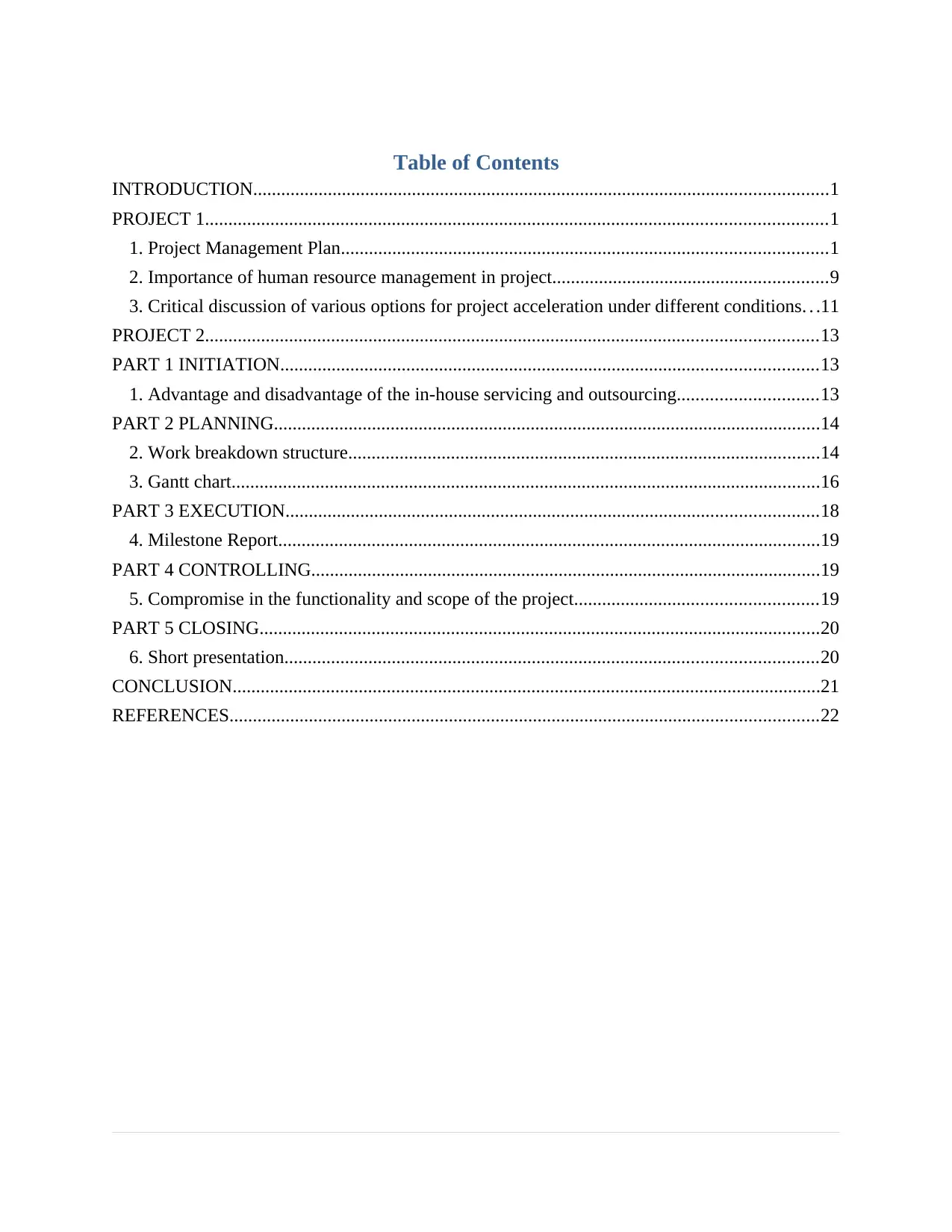
Table of Contents
INTRODUCTION...........................................................................................................................1
PROJECT 1.....................................................................................................................................1
1. Project Management Plan........................................................................................................1
2. Importance of human resource management in project...........................................................9
3. Critical discussion of various options for project acceleration under different conditions. . .11
PROJECT 2...................................................................................................................................13
PART 1 INITIATION...................................................................................................................13
1. Advantage and disadvantage of the in-house servicing and outsourcing..............................13
PART 2 PLANNING.....................................................................................................................14
2. Work breakdown structure.....................................................................................................14
3. Gantt chart..............................................................................................................................16
PART 3 EXECUTION..................................................................................................................18
4. Milestone Report....................................................................................................................19
PART 4 CONTROLLING.............................................................................................................19
5. Compromise in the functionality and scope of the project....................................................19
PART 5 CLOSING........................................................................................................................20
6. Short presentation..................................................................................................................20
CONCLUSION..............................................................................................................................21
REFERENCES..............................................................................................................................22
INTRODUCTION...........................................................................................................................1
PROJECT 1.....................................................................................................................................1
1. Project Management Plan........................................................................................................1
2. Importance of human resource management in project...........................................................9
3. Critical discussion of various options for project acceleration under different conditions. . .11
PROJECT 2...................................................................................................................................13
PART 1 INITIATION...................................................................................................................13
1. Advantage and disadvantage of the in-house servicing and outsourcing..............................13
PART 2 PLANNING.....................................................................................................................14
2. Work breakdown structure.....................................................................................................14
3. Gantt chart..............................................................................................................................16
PART 3 EXECUTION..................................................................................................................18
4. Milestone Report....................................................................................................................19
PART 4 CONTROLLING.............................................................................................................19
5. Compromise in the functionality and scope of the project....................................................19
PART 5 CLOSING........................................................................................................................20
6. Short presentation..................................................................................................................20
CONCLUSION..............................................................................................................................21
REFERENCES..............................................................................................................................22
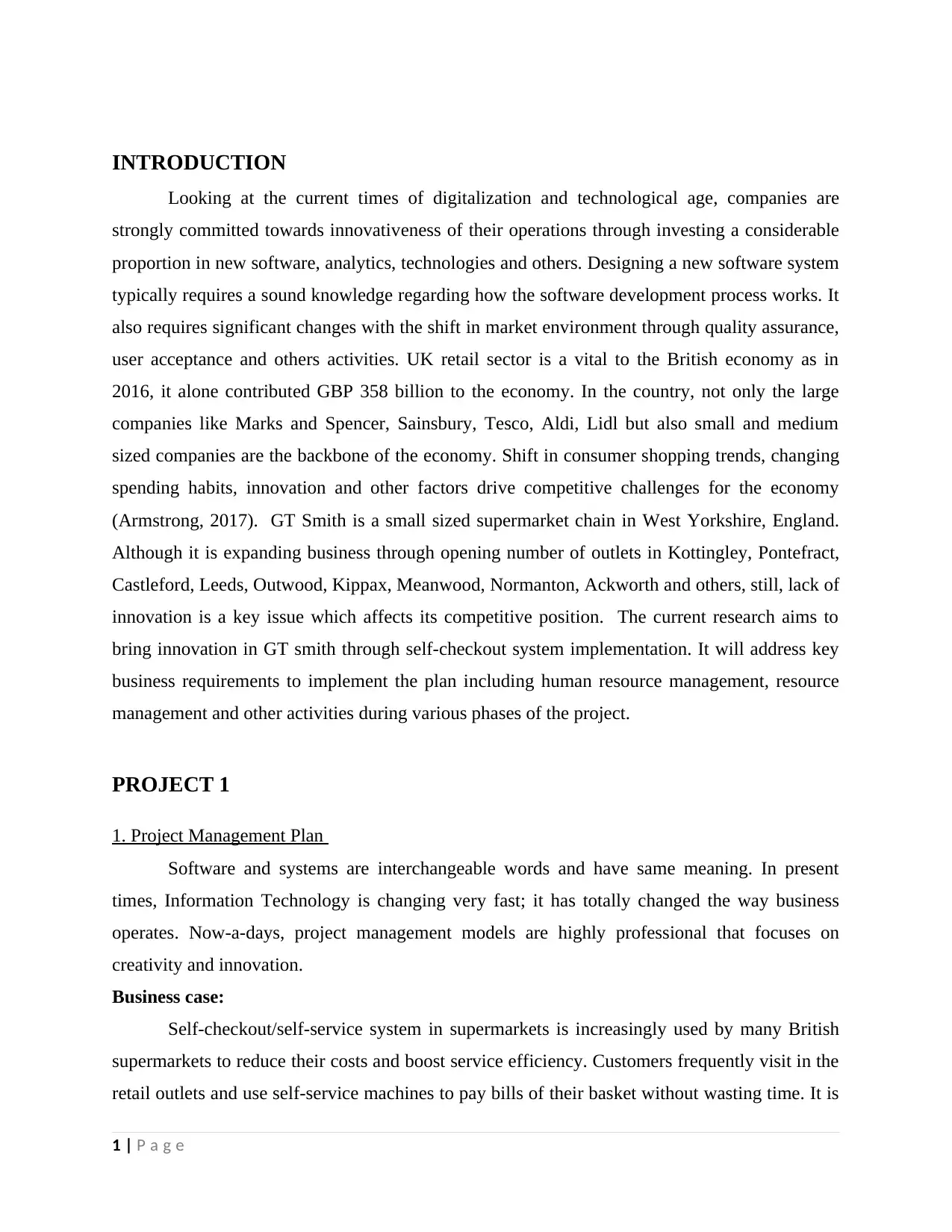
INTRODUCTION
Looking at the current times of digitalization and technological age, companies are
strongly committed towards innovativeness of their operations through investing a considerable
proportion in new software, analytics, technologies and others. Designing a new software system
typically requires a sound knowledge regarding how the software development process works. It
also requires significant changes with the shift in market environment through quality assurance,
user acceptance and others activities. UK retail sector is a vital to the British economy as in
2016, it alone contributed GBP 358 billion to the economy. In the country, not only the large
companies like Marks and Spencer, Sainsbury, Tesco, Aldi, Lidl but also small and medium
sized companies are the backbone of the economy. Shift in consumer shopping trends, changing
spending habits, innovation and other factors drive competitive challenges for the economy
(Armstrong, 2017). GT Smith is a small sized supermarket chain in West Yorkshire, England.
Although it is expanding business through opening number of outlets in Kottingley, Pontefract,
Castleford, Leeds, Outwood, Kippax, Meanwood, Normanton, Ackworth and others, still, lack of
innovation is a key issue which affects its competitive position. The current research aims to
bring innovation in GT smith through self-checkout system implementation. It will address key
business requirements to implement the plan including human resource management, resource
management and other activities during various phases of the project.
PROJECT 1
1. Project Management Plan
Software and systems are interchangeable words and have same meaning. In present
times, Information Technology is changing very fast; it has totally changed the way business
operates. Now-a-days, project management models are highly professional that focuses on
creativity and innovation.
Business case:
Self-checkout/self-service system in supermarkets is increasingly used by many British
supermarkets to reduce their costs and boost service efficiency. Customers frequently visit in the
retail outlets and use self-service machines to pay bills of their basket without wasting time. It is
1 | P a g e
Looking at the current times of digitalization and technological age, companies are
strongly committed towards innovativeness of their operations through investing a considerable
proportion in new software, analytics, technologies and others. Designing a new software system
typically requires a sound knowledge regarding how the software development process works. It
also requires significant changes with the shift in market environment through quality assurance,
user acceptance and others activities. UK retail sector is a vital to the British economy as in
2016, it alone contributed GBP 358 billion to the economy. In the country, not only the large
companies like Marks and Spencer, Sainsbury, Tesco, Aldi, Lidl but also small and medium
sized companies are the backbone of the economy. Shift in consumer shopping trends, changing
spending habits, innovation and other factors drive competitive challenges for the economy
(Armstrong, 2017). GT Smith is a small sized supermarket chain in West Yorkshire, England.
Although it is expanding business through opening number of outlets in Kottingley, Pontefract,
Castleford, Leeds, Outwood, Kippax, Meanwood, Normanton, Ackworth and others, still, lack of
innovation is a key issue which affects its competitive position. The current research aims to
bring innovation in GT smith through self-checkout system implementation. It will address key
business requirements to implement the plan including human resource management, resource
management and other activities during various phases of the project.
PROJECT 1
1. Project Management Plan
Software and systems are interchangeable words and have same meaning. In present
times, Information Technology is changing very fast; it has totally changed the way business
operates. Now-a-days, project management models are highly professional that focuses on
creativity and innovation.
Business case:
Self-checkout/self-service system in supermarkets is increasingly used by many British
supermarkets to reduce their costs and boost service efficiency. Customers frequently visit in the
retail outlets and use self-service machines to pay bills of their basket without wasting time. It is
1 | P a g e
⊘ This is a preview!⊘
Do you want full access?
Subscribe today to unlock all pages.

Trusted by 1+ million students worldwide

a mechanism that will facilitate consumer to process their purchase, scan their items and make
payments. It also enables company to circulate their existing workforce who is investing a lot of
time at one desk by shifting them to other value driving functions. Referring GT Smith, currently
in order to complete their transactions, users have to stay in long queue which increase their
waiting time (Schwalbe, 2015). Thus, by advancement through self-checkout system, every
customer will be able to create bill of item and goods purchased and pay it. They do not need to
stay longer and wait cashier. The development of self-service system by the use of RFID (Radio
Frequency Identification) will enable GT smith to rise its competitive success.
Project scope: The idea of technological advancement in the GT Smith scope includes
placing self-service system at all the branches to replace existing system of consumer payments
and stock management. Moreover, it includes reduction in existing number of checkout registers,
staffing plan and communication plan. The designed system will be integrated with bonus card
system.
Excluded criteria: Self-checkout units will be established only at the selected 5 locations
as a beginning step. All the other branches including Pontefract, Castleford, Leeds, Kippax and
Normanton is excluded from it.
Project consumers: Circulation staff members of GT Smith
End-users/Final-users: All the patron of GT smith supermarket
Project benefits
Reduce waiting time at the point of checkout
Minimize wages costs
Effective inventory management
Maximize revenue
Improve brand reputation
Key deliverables:
Installation of 2 self-checkout machines in Kottingley because, it is the largest size
supermarket of GT smith while one machinery will be placed at Meanwood, Ackworth,
Outwood, and Pontefract
Trained staff base to teach patrons about machinery usage
A well-structured marketing strategy to maximize patron awareness
Key requirements:
2 | P a g e
payments. It also enables company to circulate their existing workforce who is investing a lot of
time at one desk by shifting them to other value driving functions. Referring GT Smith, currently
in order to complete their transactions, users have to stay in long queue which increase their
waiting time (Schwalbe, 2015). Thus, by advancement through self-checkout system, every
customer will be able to create bill of item and goods purchased and pay it. They do not need to
stay longer and wait cashier. The development of self-service system by the use of RFID (Radio
Frequency Identification) will enable GT smith to rise its competitive success.
Project scope: The idea of technological advancement in the GT Smith scope includes
placing self-service system at all the branches to replace existing system of consumer payments
and stock management. Moreover, it includes reduction in existing number of checkout registers,
staffing plan and communication plan. The designed system will be integrated with bonus card
system.
Excluded criteria: Self-checkout units will be established only at the selected 5 locations
as a beginning step. All the other branches including Pontefract, Castleford, Leeds, Kippax and
Normanton is excluded from it.
Project consumers: Circulation staff members of GT Smith
End-users/Final-users: All the patron of GT smith supermarket
Project benefits
Reduce waiting time at the point of checkout
Minimize wages costs
Effective inventory management
Maximize revenue
Improve brand reputation
Key deliverables:
Installation of 2 self-checkout machines in Kottingley because, it is the largest size
supermarket of GT smith while one machinery will be placed at Meanwood, Ackworth,
Outwood, and Pontefract
Trained staff base to teach patrons about machinery usage
A well-structured marketing strategy to maximize patron awareness
Key requirements:
2 | P a g e
Paraphrase This Document
Need a fresh take? Get an instant paraphrase of this document with our AI Paraphraser

RFID based self-chekcout machinery
Operational process to tag products
RFID based stock management
Store configuration
Project Management Plan (PMP)
In current times, considering the types and complexity of the project, a number of
software has been developed for successful project management. MS Project Management
Software is one of them that is used to perform various functions like creating gantt chart,
network diagram, generating visualized reports, identifying milestone achievements and others.
WBS Task Name Duration Start Finish Predecessors Total
Slack
1
Self-checkout
system in GT
Smith
119 days 12/12/2017 5/25/2018 0 days
1.1 Business
case/Initiation 6 days 12/12/2017 12/19/2017 0 days
1.1.1 Setting out high
level requirement 1 day 12/12/2017 12/12/2017 1 day
1.1.2
Estimating
project
requirements
2 days 12/12/2017 12/13/2017 0 days
1.1.3 Developing
project charter 3 days 12/14/2017 12/18/2017 3,4 0 days
1.1.4 Approval of the
charter by board 1 day 12/19/2017 12/19/2017 5 0 days
1.2 Planning 15 days 12/19/2017 1/8/2018 1 day
1.2.1 Deciding project
scope 1 day 12/19/2017 12/19/2017 3,4,5 1 day
1.2.2
Gathering
project
requirements
2 days 12/20/2017 12/21/2017 6 0 days
1.2.3 Creating project
development plan 4 days 12/22/2017 12/27/2017 4,6,9 99
days
1.2.4
Setting technical
infrastructure &
specification
3 days 12/28/2017 1/1/2018 10 99
days
1.2.5 Deployment
plan 2 days 1/2/2018 1/3/2018 10,11 99
days
1.2.6 Maintenance
plan 2 days 1/4/2018 1/5/2018 12,10,11 99
days
3 | P a g e
Operational process to tag products
RFID based stock management
Store configuration
Project Management Plan (PMP)
In current times, considering the types and complexity of the project, a number of
software has been developed for successful project management. MS Project Management
Software is one of them that is used to perform various functions like creating gantt chart,
network diagram, generating visualized reports, identifying milestone achievements and others.
WBS Task Name Duration Start Finish Predecessors Total
Slack
1
Self-checkout
system in GT
Smith
119 days 12/12/2017 5/25/2018 0 days
1.1 Business
case/Initiation 6 days 12/12/2017 12/19/2017 0 days
1.1.1 Setting out high
level requirement 1 day 12/12/2017 12/12/2017 1 day
1.1.2
Estimating
project
requirements
2 days 12/12/2017 12/13/2017 0 days
1.1.3 Developing
project charter 3 days 12/14/2017 12/18/2017 3,4 0 days
1.1.4 Approval of the
charter by board 1 day 12/19/2017 12/19/2017 5 0 days
1.2 Planning 15 days 12/19/2017 1/8/2018 1 day
1.2.1 Deciding project
scope 1 day 12/19/2017 12/19/2017 3,4,5 1 day
1.2.2
Gathering
project
requirements
2 days 12/20/2017 12/21/2017 6 0 days
1.2.3 Creating project
development plan 4 days 12/22/2017 12/27/2017 4,6,9 99
days
1.2.4
Setting technical
infrastructure &
specification
3 days 12/28/2017 1/1/2018 10 99
days
1.2.5 Deployment
plan 2 days 1/2/2018 1/3/2018 10,11 99
days
1.2.6 Maintenance
plan 2 days 1/4/2018 1/5/2018 12,10,11 99
days
3 | P a g e
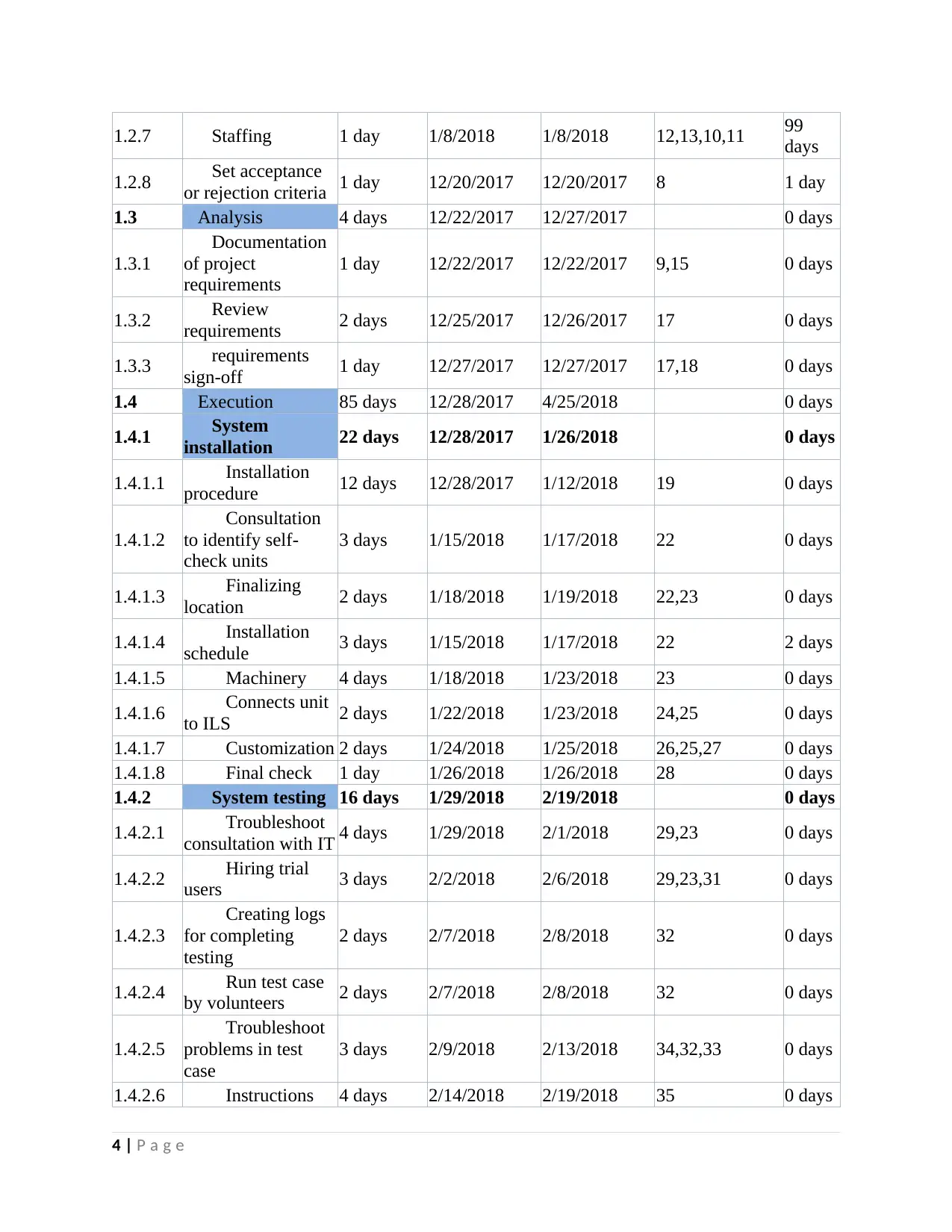
1.2.7 Staffing 1 day 1/8/2018 1/8/2018 12,13,10,11 99
days
1.2.8 Set acceptance
or rejection criteria 1 day 12/20/2017 12/20/2017 8 1 day
1.3 Analysis 4 days 12/22/2017 12/27/2017 0 days
1.3.1
Documentation
of project
requirements
1 day 12/22/2017 12/22/2017 9,15 0 days
1.3.2 Review
requirements 2 days 12/25/2017 12/26/2017 17 0 days
1.3.3 requirements
sign-off 1 day 12/27/2017 12/27/2017 17,18 0 days
1.4 Execution 85 days 12/28/2017 4/25/2018 0 days
1.4.1 System
installation 22 days 12/28/2017 1/26/2018 0 days
1.4.1.1 Installation
procedure 12 days 12/28/2017 1/12/2018 19 0 days
1.4.1.2
Consultation
to identify self-
check units
3 days 1/15/2018 1/17/2018 22 0 days
1.4.1.3 Finalizing
location 2 days 1/18/2018 1/19/2018 22,23 0 days
1.4.1.4 Installation
schedule 3 days 1/15/2018 1/17/2018 22 2 days
1.4.1.5 Machinery 4 days 1/18/2018 1/23/2018 23 0 days
1.4.1.6 Connects unit
to ILS 2 days 1/22/2018 1/23/2018 24,25 0 days
1.4.1.7 Customization 2 days 1/24/2018 1/25/2018 26,25,27 0 days
1.4.1.8 Final check 1 day 1/26/2018 1/26/2018 28 0 days
1.4.2 System testing 16 days 1/29/2018 2/19/2018 0 days
1.4.2.1 Troubleshoot
consultation with IT 4 days 1/29/2018 2/1/2018 29,23 0 days
1.4.2.2 Hiring trial
users 3 days 2/2/2018 2/6/2018 29,23,31 0 days
1.4.2.3
Creating logs
for completing
testing
2 days 2/7/2018 2/8/2018 32 0 days
1.4.2.4 Run test case
by volunteers 2 days 2/7/2018 2/8/2018 32 0 days
1.4.2.5
Troubleshoot
problems in test
case
3 days 2/9/2018 2/13/2018 34,32,33 0 days
1.4.2.6 Instructions 4 days 2/14/2018 2/19/2018 35 0 days
4 | P a g e
days
1.2.8 Set acceptance
or rejection criteria 1 day 12/20/2017 12/20/2017 8 1 day
1.3 Analysis 4 days 12/22/2017 12/27/2017 0 days
1.3.1
Documentation
of project
requirements
1 day 12/22/2017 12/22/2017 9,15 0 days
1.3.2 Review
requirements 2 days 12/25/2017 12/26/2017 17 0 days
1.3.3 requirements
sign-off 1 day 12/27/2017 12/27/2017 17,18 0 days
1.4 Execution 85 days 12/28/2017 4/25/2018 0 days
1.4.1 System
installation 22 days 12/28/2017 1/26/2018 0 days
1.4.1.1 Installation
procedure 12 days 12/28/2017 1/12/2018 19 0 days
1.4.1.2
Consultation
to identify self-
check units
3 days 1/15/2018 1/17/2018 22 0 days
1.4.1.3 Finalizing
location 2 days 1/18/2018 1/19/2018 22,23 0 days
1.4.1.4 Installation
schedule 3 days 1/15/2018 1/17/2018 22 2 days
1.4.1.5 Machinery 4 days 1/18/2018 1/23/2018 23 0 days
1.4.1.6 Connects unit
to ILS 2 days 1/22/2018 1/23/2018 24,25 0 days
1.4.1.7 Customization 2 days 1/24/2018 1/25/2018 26,25,27 0 days
1.4.1.8 Final check 1 day 1/26/2018 1/26/2018 28 0 days
1.4.2 System testing 16 days 1/29/2018 2/19/2018 0 days
1.4.2.1 Troubleshoot
consultation with IT 4 days 1/29/2018 2/1/2018 29,23 0 days
1.4.2.2 Hiring trial
users 3 days 2/2/2018 2/6/2018 29,23,31 0 days
1.4.2.3
Creating logs
for completing
testing
2 days 2/7/2018 2/8/2018 32 0 days
1.4.2.4 Run test case
by volunteers 2 days 2/7/2018 2/8/2018 32 0 days
1.4.2.5
Troubleshoot
problems in test
case
3 days 2/9/2018 2/13/2018 34,32,33 0 days
1.4.2.6 Instructions 4 days 2/14/2018 2/19/2018 35 0 days
4 | P a g e
⊘ This is a preview!⊘
Do you want full access?
Subscribe today to unlock all pages.

Trusted by 1+ million students worldwide
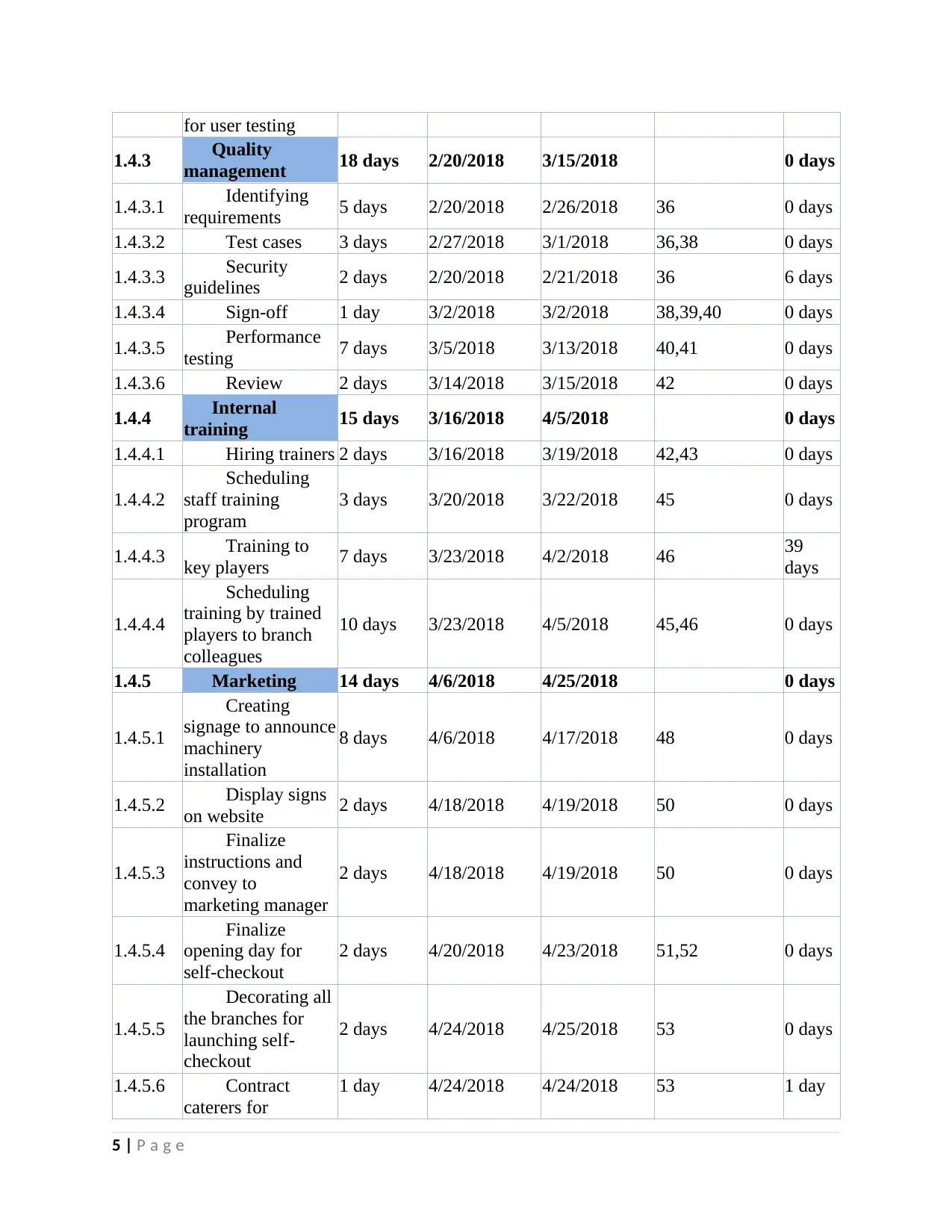
for user testing
1.4.3 Quality
management 18 days 2/20/2018 3/15/2018 0 days
1.4.3.1 Identifying
requirements 5 days 2/20/2018 2/26/2018 36 0 days
1.4.3.2 Test cases 3 days 2/27/2018 3/1/2018 36,38 0 days
1.4.3.3 Security
guidelines 2 days 2/20/2018 2/21/2018 36 6 days
1.4.3.4 Sign-off 1 day 3/2/2018 3/2/2018 38,39,40 0 days
1.4.3.5 Performance
testing 7 days 3/5/2018 3/13/2018 40,41 0 days
1.4.3.6 Review 2 days 3/14/2018 3/15/2018 42 0 days
1.4.4 Internal
training 15 days 3/16/2018 4/5/2018 0 days
1.4.4.1 Hiring trainers 2 days 3/16/2018 3/19/2018 42,43 0 days
1.4.4.2
Scheduling
staff training
program
3 days 3/20/2018 3/22/2018 45 0 days
1.4.4.3 Training to
key players 7 days 3/23/2018 4/2/2018 46 39
days
1.4.4.4
Scheduling
training by trained
players to branch
colleagues
10 days 3/23/2018 4/5/2018 45,46 0 days
1.4.5 Marketing 14 days 4/6/2018 4/25/2018 0 days
1.4.5.1
Creating
signage to announce
machinery
installation
8 days 4/6/2018 4/17/2018 48 0 days
1.4.5.2 Display signs
on website 2 days 4/18/2018 4/19/2018 50 0 days
1.4.5.3
Finalize
instructions and
convey to
marketing manager
2 days 4/18/2018 4/19/2018 50 0 days
1.4.5.4
Finalize
opening day for
self-checkout
2 days 4/20/2018 4/23/2018 51,52 0 days
1.4.5.5
Decorating all
the branches for
launching self-
checkout
2 days 4/24/2018 4/25/2018 53 0 days
1.4.5.6 Contract
caterers for
1 day 4/24/2018 4/24/2018 53 1 day
5 | P a g e
1.4.3 Quality
management 18 days 2/20/2018 3/15/2018 0 days
1.4.3.1 Identifying
requirements 5 days 2/20/2018 2/26/2018 36 0 days
1.4.3.2 Test cases 3 days 2/27/2018 3/1/2018 36,38 0 days
1.4.3.3 Security
guidelines 2 days 2/20/2018 2/21/2018 36 6 days
1.4.3.4 Sign-off 1 day 3/2/2018 3/2/2018 38,39,40 0 days
1.4.3.5 Performance
testing 7 days 3/5/2018 3/13/2018 40,41 0 days
1.4.3.6 Review 2 days 3/14/2018 3/15/2018 42 0 days
1.4.4 Internal
training 15 days 3/16/2018 4/5/2018 0 days
1.4.4.1 Hiring trainers 2 days 3/16/2018 3/19/2018 42,43 0 days
1.4.4.2
Scheduling
staff training
program
3 days 3/20/2018 3/22/2018 45 0 days
1.4.4.3 Training to
key players 7 days 3/23/2018 4/2/2018 46 39
days
1.4.4.4
Scheduling
training by trained
players to branch
colleagues
10 days 3/23/2018 4/5/2018 45,46 0 days
1.4.5 Marketing 14 days 4/6/2018 4/25/2018 0 days
1.4.5.1
Creating
signage to announce
machinery
installation
8 days 4/6/2018 4/17/2018 48 0 days
1.4.5.2 Display signs
on website 2 days 4/18/2018 4/19/2018 50 0 days
1.4.5.3
Finalize
instructions and
convey to
marketing manager
2 days 4/18/2018 4/19/2018 50 0 days
1.4.5.4
Finalize
opening day for
self-checkout
2 days 4/20/2018 4/23/2018 51,52 0 days
1.4.5.5
Decorating all
the branches for
launching self-
checkout
2 days 4/24/2018 4/25/2018 53 0 days
1.4.5.6 Contract
caterers for
1 day 4/24/2018 4/24/2018 53 1 day
5 | P a g e
Paraphrase This Document
Need a fresh take? Get an instant paraphrase of this document with our AI Paraphraser
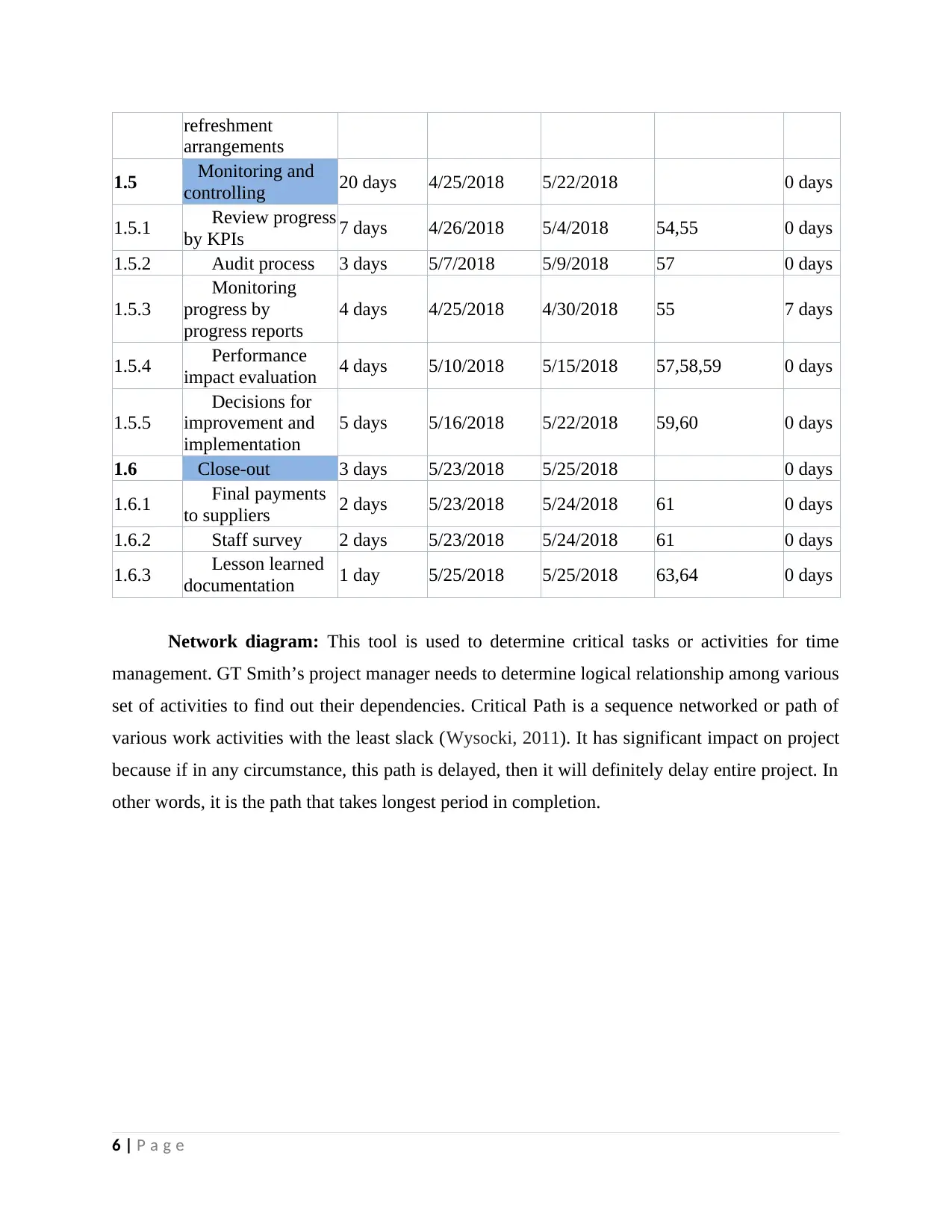
refreshment
arrangements
1.5 Monitoring and
controlling 20 days 4/25/2018 5/22/2018 0 days
1.5.1 Review progress
by KPIs 7 days 4/26/2018 5/4/2018 54,55 0 days
1.5.2 Audit process 3 days 5/7/2018 5/9/2018 57 0 days
1.5.3
Monitoring
progress by
progress reports
4 days 4/25/2018 4/30/2018 55 7 days
1.5.4 Performance
impact evaluation 4 days 5/10/2018 5/15/2018 57,58,59 0 days
1.5.5
Decisions for
improvement and
implementation
5 days 5/16/2018 5/22/2018 59,60 0 days
1.6 Close-out 3 days 5/23/2018 5/25/2018 0 days
1.6.1 Final payments
to suppliers 2 days 5/23/2018 5/24/2018 61 0 days
1.6.2 Staff survey 2 days 5/23/2018 5/24/2018 61 0 days
1.6.3 Lesson learned
documentation 1 day 5/25/2018 5/25/2018 63,64 0 days
Network diagram: This tool is used to determine critical tasks or activities for time
management. GT Smith’s project manager needs to determine logical relationship among various
set of activities to find out their dependencies. Critical Path is a sequence networked or path of
various work activities with the least slack (Wysocki, 2011). It has significant impact on project
because if in any circumstance, this path is delayed, then it will definitely delay entire project. In
other words, it is the path that takes longest period in completion.
6 | P a g e
arrangements
1.5 Monitoring and
controlling 20 days 4/25/2018 5/22/2018 0 days
1.5.1 Review progress
by KPIs 7 days 4/26/2018 5/4/2018 54,55 0 days
1.5.2 Audit process 3 days 5/7/2018 5/9/2018 57 0 days
1.5.3
Monitoring
progress by
progress reports
4 days 4/25/2018 4/30/2018 55 7 days
1.5.4 Performance
impact evaluation 4 days 5/10/2018 5/15/2018 57,58,59 0 days
1.5.5
Decisions for
improvement and
implementation
5 days 5/16/2018 5/22/2018 59,60 0 days
1.6 Close-out 3 days 5/23/2018 5/25/2018 0 days
1.6.1 Final payments
to suppliers 2 days 5/23/2018 5/24/2018 61 0 days
1.6.2 Staff survey 2 days 5/23/2018 5/24/2018 61 0 days
1.6.3 Lesson learned
documentation 1 day 5/25/2018 5/25/2018 63,64 0 days
Network diagram: This tool is used to determine critical tasks or activities for time
management. GT Smith’s project manager needs to determine logical relationship among various
set of activities to find out their dependencies. Critical Path is a sequence networked or path of
various work activities with the least slack (Wysocki, 2011). It has significant impact on project
because if in any circumstance, this path is delayed, then it will definitely delay entire project. In
other words, it is the path that takes longest period in completion.
6 | P a g e
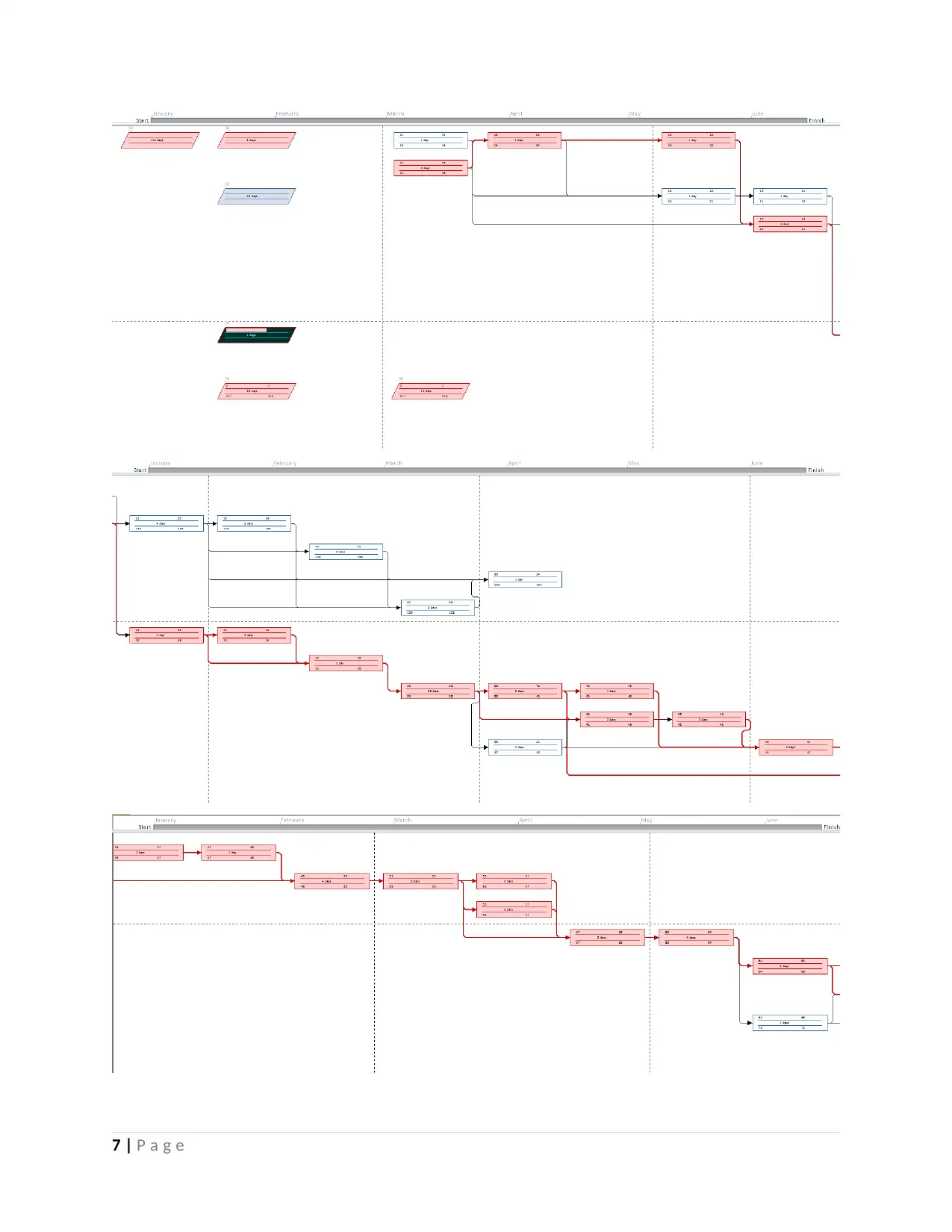
7 | P a g e
⊘ This is a preview!⊘
Do you want full access?
Subscribe today to unlock all pages.

Trusted by 1+ million students worldwide
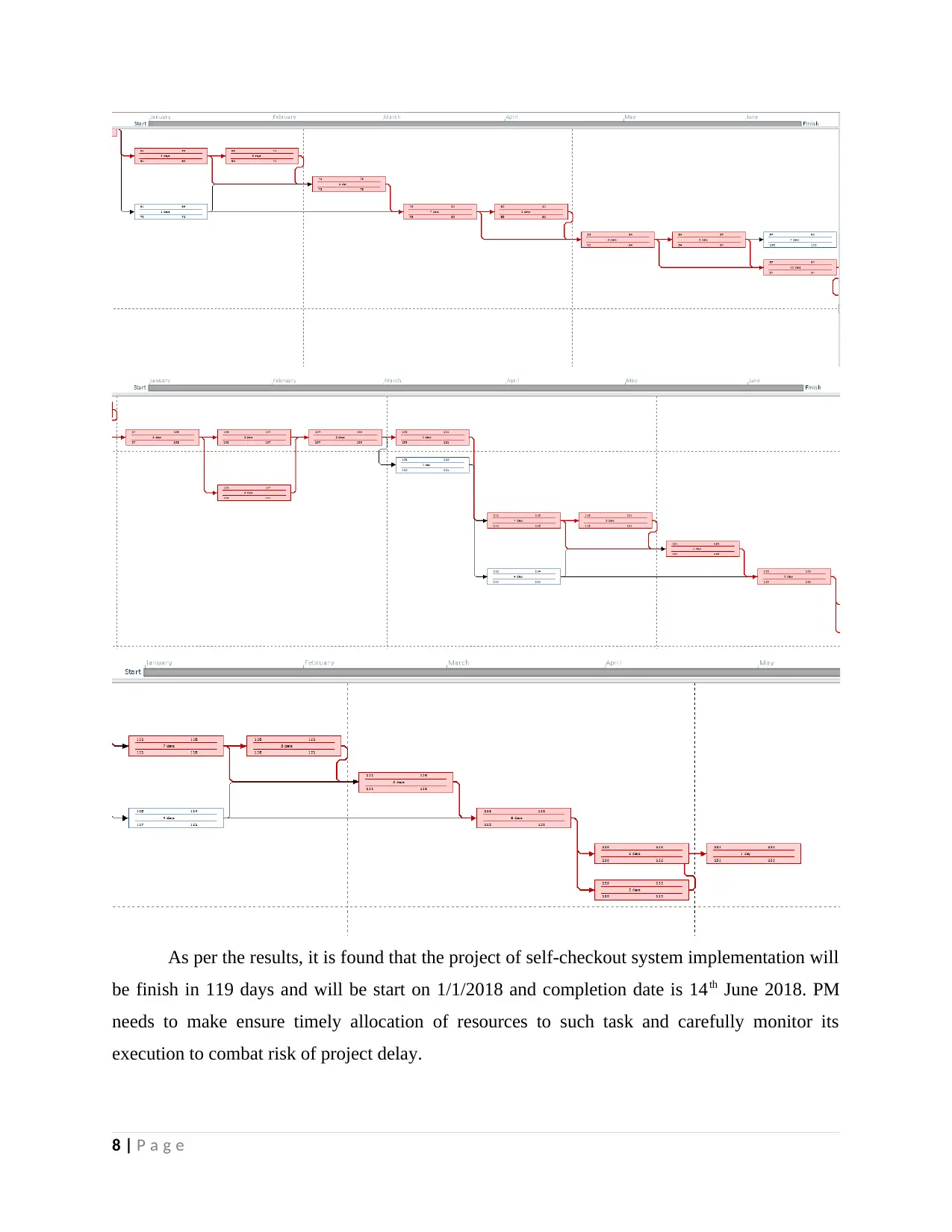
As per the results, it is found that the project of self-checkout system implementation will
be finish in 119 days and will be start on 1/1/2018 and completion date is 14th June 2018. PM
needs to make ensure timely allocation of resources to such task and carefully monitor its
execution to combat risk of project delay.
8 | P a g e
be finish in 119 days and will be start on 1/1/2018 and completion date is 14th June 2018. PM
needs to make ensure timely allocation of resources to such task and carefully monitor its
execution to combat risk of project delay.
8 | P a g e
Paraphrase This Document
Need a fresh take? Get an instant paraphrase of this document with our AI Paraphraser

2. Importance of human resource management in project
Every project is implemented and carried out by human beings, hence, it is obvious, and
their skills, talent and capabilities have a strong influence over the project success. Staffing plan
encompasses various activities including identifying HR requirement, their skills, and sources
whether internal or external or mixed, training and development, management and others. The
current plan is about developing self-checkout system, which requires digitalized workforce who
is able to deal with the self-checkout machines.
According to the views of Burke (2013), HR management consist of all the efforts and
activities that company taken to increase workers performance to their greatest level
corresponding to the business goals. The process comprises multiple of activities and functions
including recruitment & selection, orientation, maintaining good working conditions, managing
workers relationship, training and development and conflicts management. Meredith and Mantel
(2011), said that there are two options to captivate qualified candidates as per the set criteria that
are internal and external. First is a process wherein existing workers employed at the company is
hired to the project activities while, later approach regards to hiring new staff from the outside
sources like recruitment agencies, job advertisement, campus placement and others.
Considering our plan to implement self-checkout system in GT smith, staffing is the key
requirement. Company will need members to install new machinery, train existing members,
marketing activities, test the functioning of the system and others.
Table 1 Human Resource plan for Self-checkout system project
Staffing
requirement
Key duties
Circulation staff To work on new working station after self-checkout system
Project sponsor
(lead)
To assign circulation staff to other tasks or activities
To establish necessary guidelines and make rules for machinery
usage
To make plans to minimize possible threats or risks associated
with the self-checkout
To keep close monitoring of the self-checkout activities by the
customers and reduce theft
Project team To timely complete assigned duties and job responsibilities
9 | P a g e
Every project is implemented and carried out by human beings, hence, it is obvious, and
their skills, talent and capabilities have a strong influence over the project success. Staffing plan
encompasses various activities including identifying HR requirement, their skills, and sources
whether internal or external or mixed, training and development, management and others. The
current plan is about developing self-checkout system, which requires digitalized workforce who
is able to deal with the self-checkout machines.
According to the views of Burke (2013), HR management consist of all the efforts and
activities that company taken to increase workers performance to their greatest level
corresponding to the business goals. The process comprises multiple of activities and functions
including recruitment & selection, orientation, maintaining good working conditions, managing
workers relationship, training and development and conflicts management. Meredith and Mantel
(2011), said that there are two options to captivate qualified candidates as per the set criteria that
are internal and external. First is a process wherein existing workers employed at the company is
hired to the project activities while, later approach regards to hiring new staff from the outside
sources like recruitment agencies, job advertisement, campus placement and others.
Considering our plan to implement self-checkout system in GT smith, staffing is the key
requirement. Company will need members to install new machinery, train existing members,
marketing activities, test the functioning of the system and others.
Table 1 Human Resource plan for Self-checkout system project
Staffing
requirement
Key duties
Circulation staff To work on new working station after self-checkout system
Project sponsor
(lead)
To assign circulation staff to other tasks or activities
To establish necessary guidelines and make rules for machinery
usage
To make plans to minimize possible threats or risks associated
with the self-checkout
To keep close monitoring of the self-checkout activities by the
customers and reduce theft
Project team To timely complete assigned duties and job responsibilities
9 | P a g e
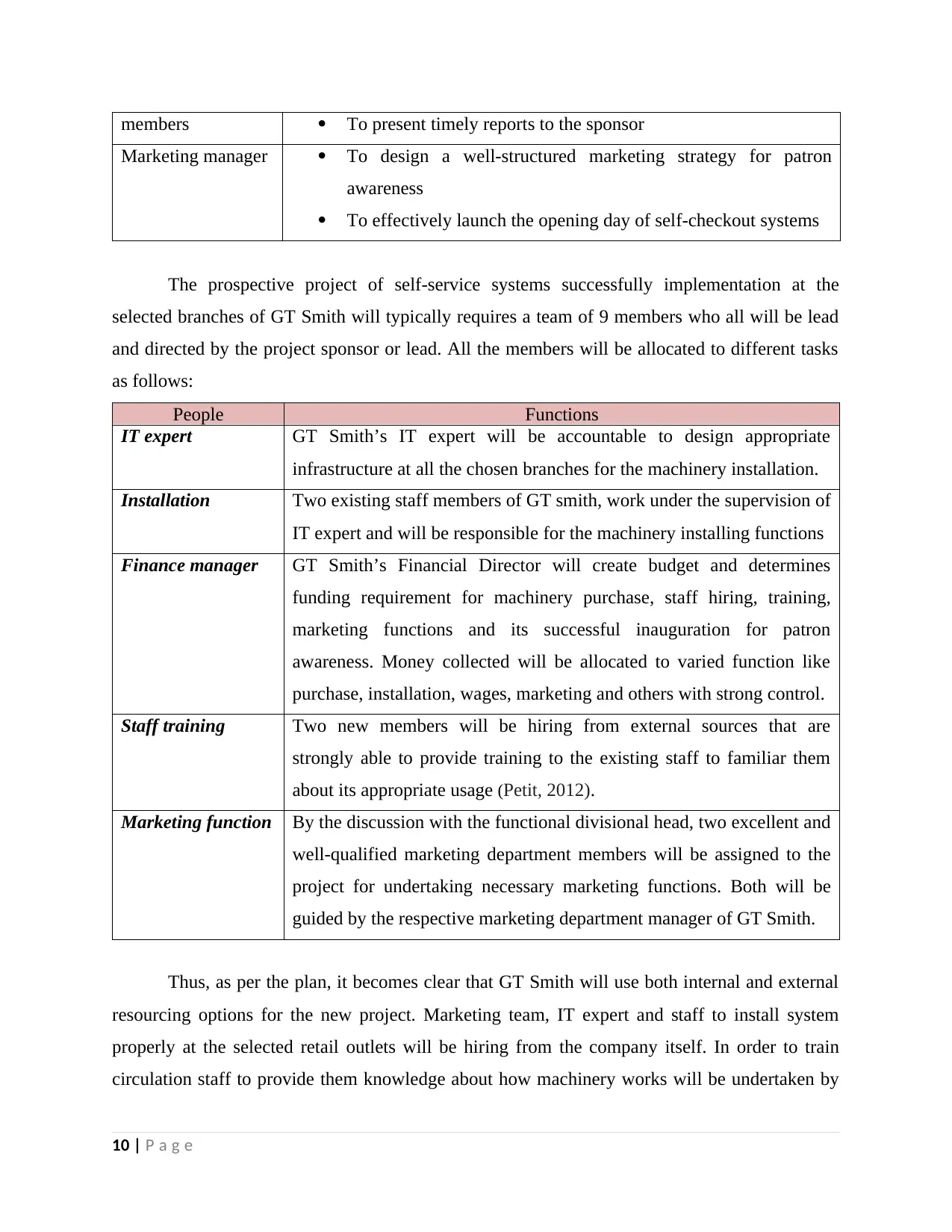
members To present timely reports to the sponsor
Marketing manager To design a well-structured marketing strategy for patron
awareness
To effectively launch the opening day of self-checkout systems
The prospective project of self-service systems successfully implementation at the
selected branches of GT Smith will typically requires a team of 9 members who all will be lead
and directed by the project sponsor or lead. All the members will be allocated to different tasks
as follows:
People Functions
IT expert GT Smith’s IT expert will be accountable to design appropriate
infrastructure at all the chosen branches for the machinery installation.
Installation Two existing staff members of GT smith, work under the supervision of
IT expert and will be responsible for the machinery installing functions
Finance manager GT Smith’s Financial Director will create budget and determines
funding requirement for machinery purchase, staff hiring, training,
marketing functions and its successful inauguration for patron
awareness. Money collected will be allocated to varied function like
purchase, installation, wages, marketing and others with strong control.
Staff training Two new members will be hiring from external sources that are
strongly able to provide training to the existing staff to familiar them
about its appropriate usage (Petit, 2012).
Marketing function By the discussion with the functional divisional head, two excellent and
well-qualified marketing department members will be assigned to the
project for undertaking necessary marketing functions. Both will be
guided by the respective marketing department manager of GT Smith.
Thus, as per the plan, it becomes clear that GT Smith will use both internal and external
resourcing options for the new project. Marketing team, IT expert and staff to install system
properly at the selected retail outlets will be hiring from the company itself. In order to train
circulation staff to provide them knowledge about how machinery works will be undertaken by
10 | P a g e
Marketing manager To design a well-structured marketing strategy for patron
awareness
To effectively launch the opening day of self-checkout systems
The prospective project of self-service systems successfully implementation at the
selected branches of GT Smith will typically requires a team of 9 members who all will be lead
and directed by the project sponsor or lead. All the members will be allocated to different tasks
as follows:
People Functions
IT expert GT Smith’s IT expert will be accountable to design appropriate
infrastructure at all the chosen branches for the machinery installation.
Installation Two existing staff members of GT smith, work under the supervision of
IT expert and will be responsible for the machinery installing functions
Finance manager GT Smith’s Financial Director will create budget and determines
funding requirement for machinery purchase, staff hiring, training,
marketing functions and its successful inauguration for patron
awareness. Money collected will be allocated to varied function like
purchase, installation, wages, marketing and others with strong control.
Staff training Two new members will be hiring from external sources that are
strongly able to provide training to the existing staff to familiar them
about its appropriate usage (Petit, 2012).
Marketing function By the discussion with the functional divisional head, two excellent and
well-qualified marketing department members will be assigned to the
project for undertaking necessary marketing functions. Both will be
guided by the respective marketing department manager of GT Smith.
Thus, as per the plan, it becomes clear that GT Smith will use both internal and external
resourcing options for the new project. Marketing team, IT expert and staff to install system
properly at the selected retail outlets will be hiring from the company itself. In order to train
circulation staff to provide them knowledge about how machinery works will be undertaken by
10 | P a g e
⊘ This is a preview!⊘
Do you want full access?
Subscribe today to unlock all pages.

Trusted by 1+ million students worldwide
1 out of 26
Related Documents
Your All-in-One AI-Powered Toolkit for Academic Success.
+13062052269
info@desklib.com
Available 24*7 on WhatsApp / Email
![[object Object]](/_next/static/media/star-bottom.7253800d.svg)
Unlock your academic potential
Copyright © 2020–2025 A2Z Services. All Rights Reserved. Developed and managed by ZUCOL.




